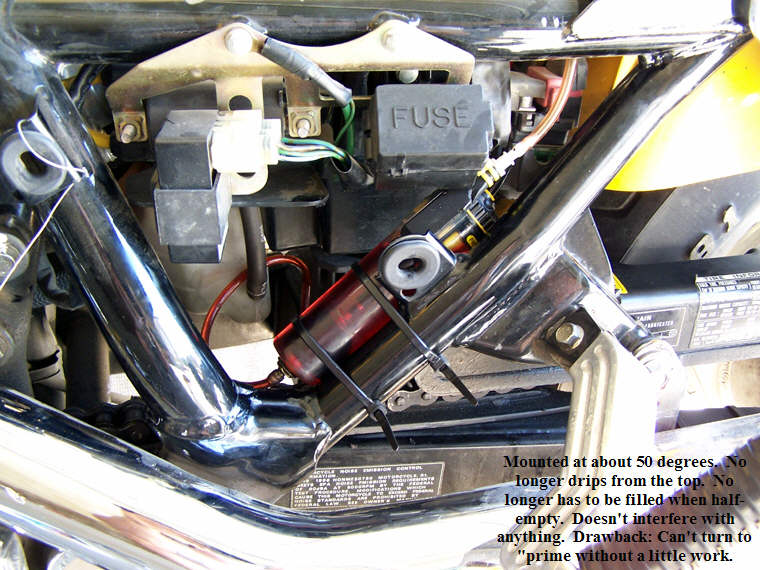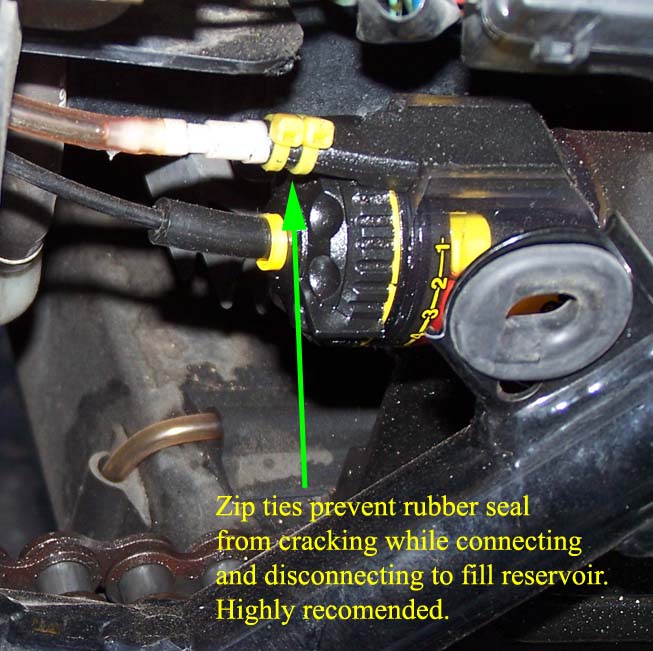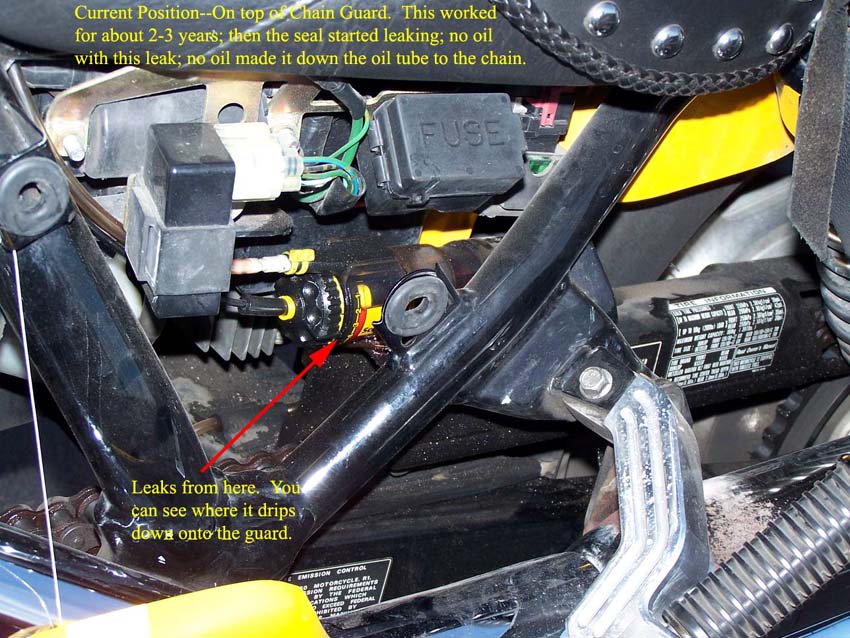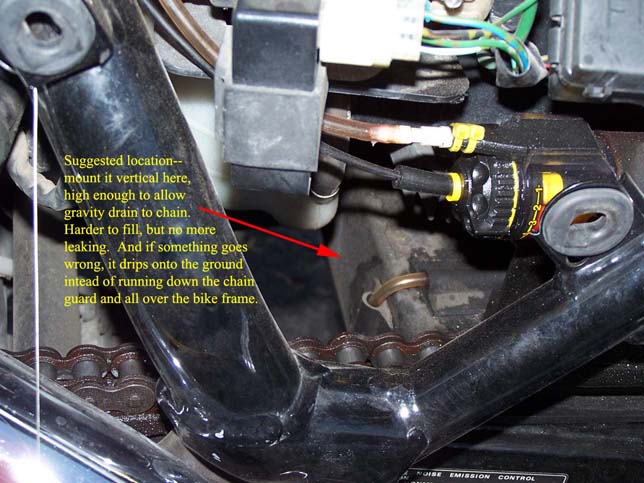
Scott Oiler Install - Honda Manga
The ScottOiler advertisement says it pulls 3cc of air to lift the plunger/pin combination. How far it pulls up depends on where you have the dial turned.
The exit point is a thin tube you slide into the plastic
hose that only drips lightly. The small diameter means the oil doesn't drip out
when the motorcycle isn't running/plunger isn't up.
You can see a picture of the
dispenser
tip here. That's on a clean bike; much better than any picture
of mine. The white thing is a piece of hanger he attached to the black
dispenser tube so he could bend it exactly how he wanted it. I
didn't need it, but it is a good idea.
You can vary oil flow by either changing the dispenser dial, or by using thicker or thinner oil. In the Dallas or
Tucson summers, I use a thicker oil. In the winter I should switch to
thinner oil, but I really just turn the dial more. Genuine ScottOil sells
for $10 per half liter. Chain or gear oil is much cheaper and works just as
well or better (less sling-off); I've seen other people say they use ATF (which
is also an oil product).
Prices: (Jan 2009)
Pashnit.com: $135
http://www.pashnit.com/product/scottoiler.html
Aerostitch: $147
http://www.aerostich.com/catalog/US/Scottoiler-p-16855.html
Chain Oiler: $159
http://www.chain-oiler.com/
Riderstation: $159.
http://www.riderstation.com/catalog/products.php?id=23
Holeshot: $159
http://www.holeshot.com/
If
something goes wrong or you want one of the "extra" parts (dual-side oiler tip,
extra mounting pieces) you can google "ScotOiler Parts". Last time I
checked RiderStation and ChainOiler sells the individual parts.
Please note the picture below; that "zip tie modification" is highly
recommended--it's why I had to order extra parts!
When I broke reservoir/metering valve (the most expensive part)
in Jan 2009, this is what I found:
Direct from ScotOiler UK: £30.64 +
£2.45 shipping = £33.09 = $44.48
Rider Station:
$80 + shipping
ChainOiler:
$69 includes shipping.
The time I've saved and not having to get the chain replaced yet meant that
it has been more than worth the price of the unit. 35,000 miles and I'm barely into the chain
adjustment on a press-fit chain. The chains run about $130 (standard) to
$180 (supposed to be more durable), and my friend who's a gentile rider with a
Honda Shadow 750 replaced his at 20k miles. I expect to get at least 60k
out of my chain at this rate--do the math and the oiler saves you a great deal
of time (it takes a couple minutes to fill, and you do it once every few
months), but also money.
A graphic of the entire system and how it works is here:
http://www.riderstation.com/oiler.php
Installation guides:
http://www.scottoiler.co.uk/support_installation-guides.asp
They also sell reservoir kits that install behind your license plate, or even a
"reservoir bag" you can mount up in your fender. Just don't hit a big bump!
There's dual-tip feeders (for both sides of the chain at once) if you're a
dirt-bike rider, etc. I just got the basic kit.
And if an idiot like me can install it.....
I've seen a bunch of posts on the MOOT and the Magna Riders Assn about not knowing where to install the Scott Automatic Chain Oiler. I messed around with different locations and the various mounting hardware (I'd ordered all the extra mounting accessories). My Eureka moment came when I threw out all all their mounting pieces and just zip-tied the reservoir in. I can fill it almost to the top (your only supposed to go up to the black piece anyway; otherwise it can't vent properly). To keep the delivery tube from hitting the chain, I looped it through the coolant reservoir. Even through the tube loops up higher than the bottom of the reservoir, it will still work because the final end point is lower then the bottom of the reservoir. If you don't get it, here's a link to Wikipedia siphon theory, with pictures. Water (and oil) can be gravity fed and still flow uphill, as long as the end point is low enough.
I started the bike up and was able to see the plunger at the bottom pop up when vacuum was on (engine running) and drop back when the vacuum was off (engine off). The dial at the top adjusts from 1 to 9; I usually keep it around 2 or 3. You're supposed to be able turn it to prime and allow it to free-flow, that way when the drain-to-chain tube is empty you can force oil down the tube. However, I've found this works fine when it's turned on 9; I can actually force oil down the tube even at lower dial levels.

The top white/clear line is just a vent tube, so that air can get in to let the oil drip out. It's also the fill point; the plastic tube pulls off and the fill bottle snaps on to the connection. Well designed. The black tube coming out the center is connected to a motorcycle vacuum line which pull the plunger up or down (turns oiler on or off). I had a straight connection already where two vacuum lines met; I replaced it with the supplied "T" and added in the oiler.
The flat, black rubber piece is thin where the hard plastic tube goes in, and the slight bending when filling it caused it to crack after a while. I protected the new one with a couple of zip ties. Once I put the zip ties on to protect the thin point, no more cracking. You might use shrink wrap as well, but this was easier.

Bellow was my original position, mounted on the chain guard. After a few years mounted here, oil started dripping out of the dial and running down the bottom of the chain guard. I suspect it was from grit getting in the seal between the bottle and the dial, then me turning the dial and grinding the seal. Plus, it was a little annoying to have to keep filling it up every time it was half-empty.

This was my suggested location. The bottom of the Scot Oiler obviously has to be higher than bottom of the chain (where the oil ends up) for gravity to pull the oil down. The bottle will only drain as low as the nozzle on the chain. I tried mounting vertical on this crossmember, but you have to drop the oiler into the plastic mounting loops. I'd have to put the reservoir in the plastic loops then glue it down; I would not be able to remove it unless I broke the loops off. Plus, it would be awkward to fill.
